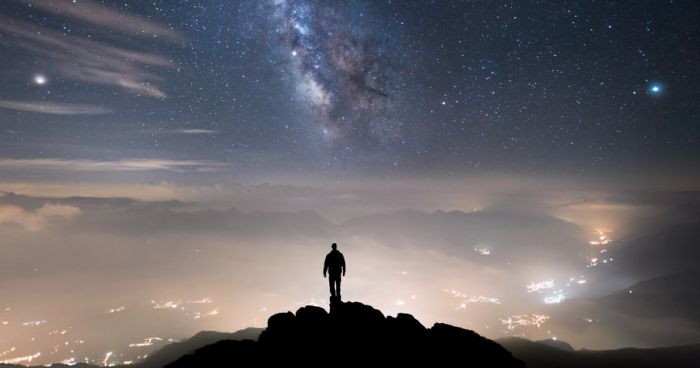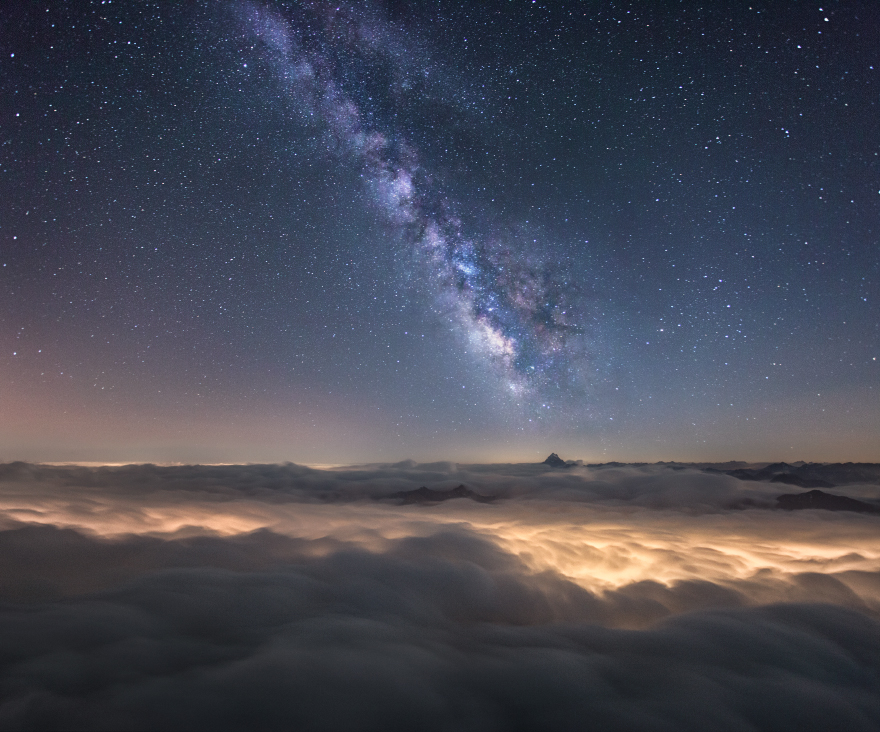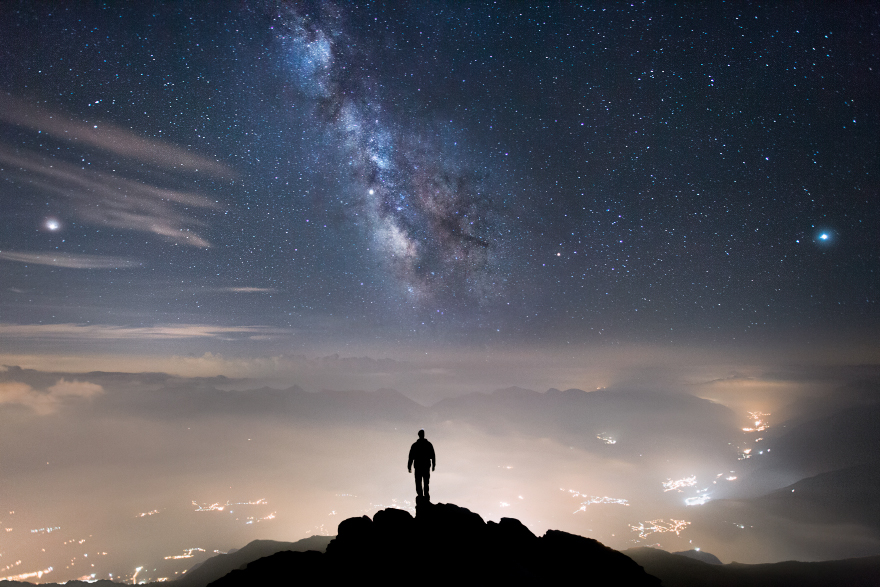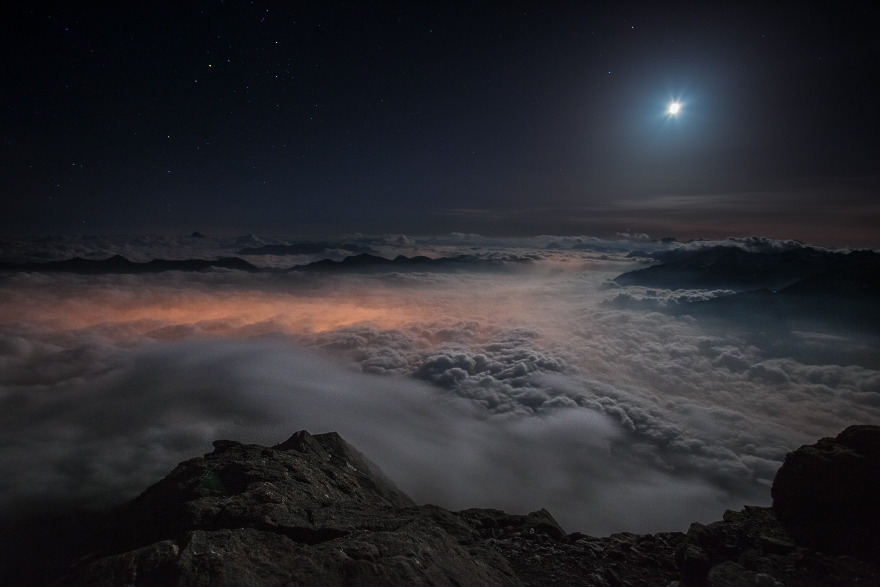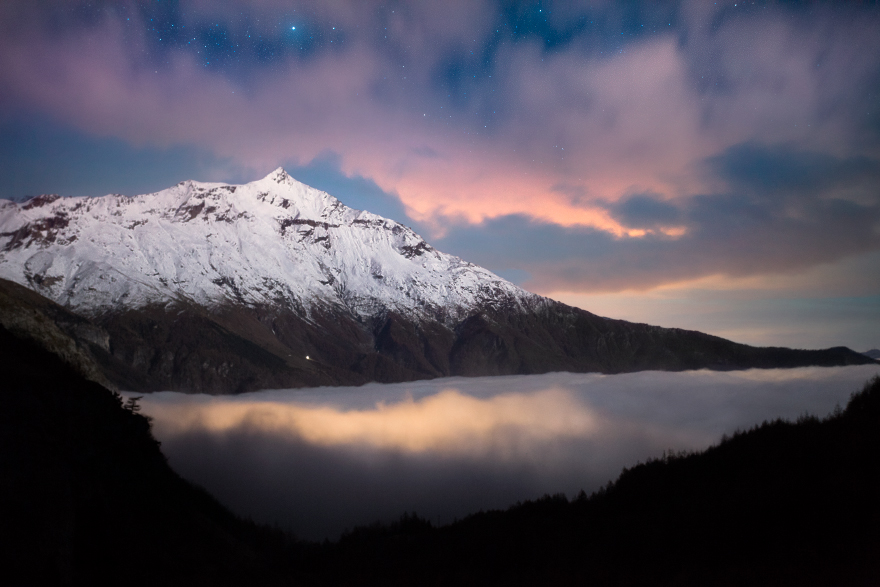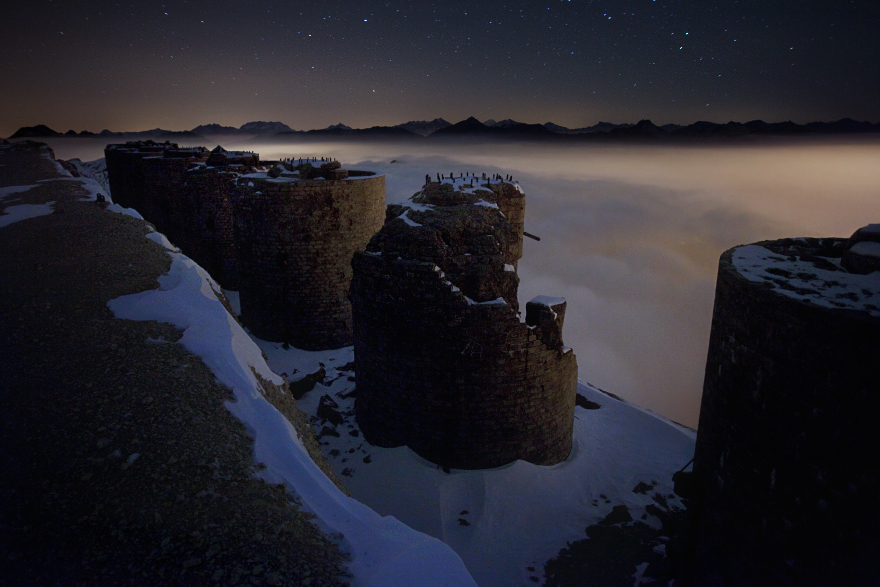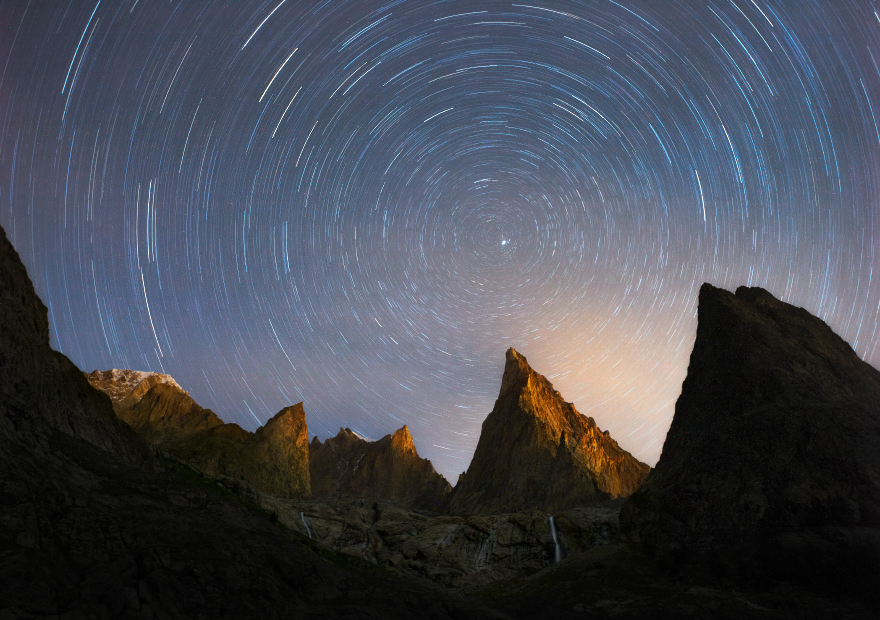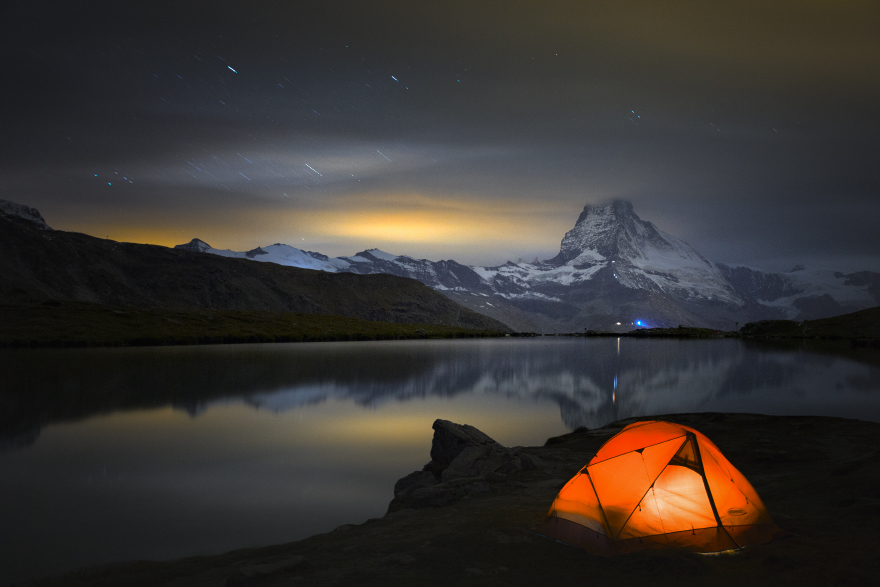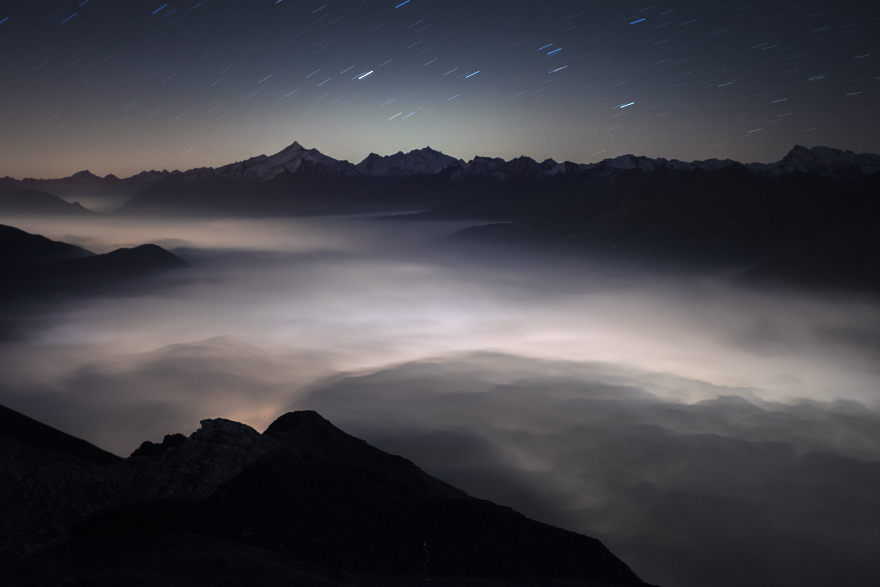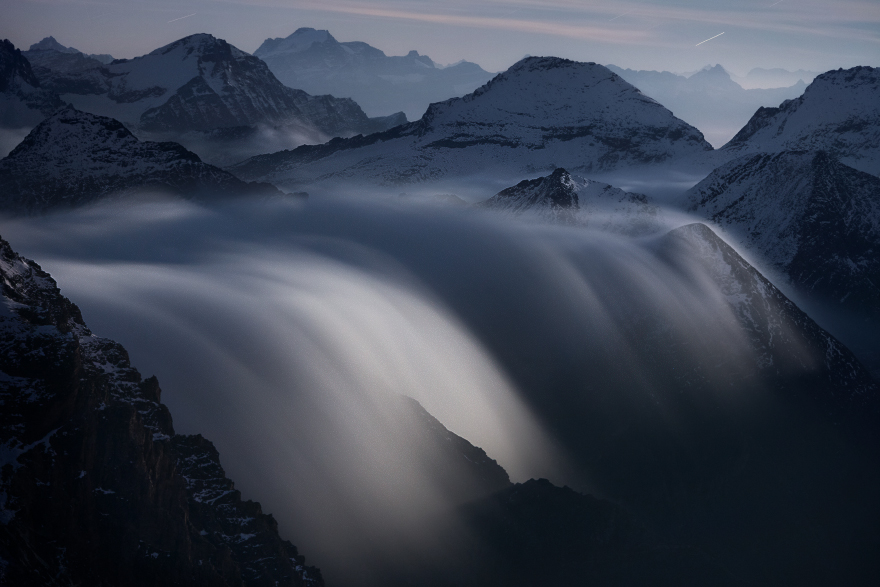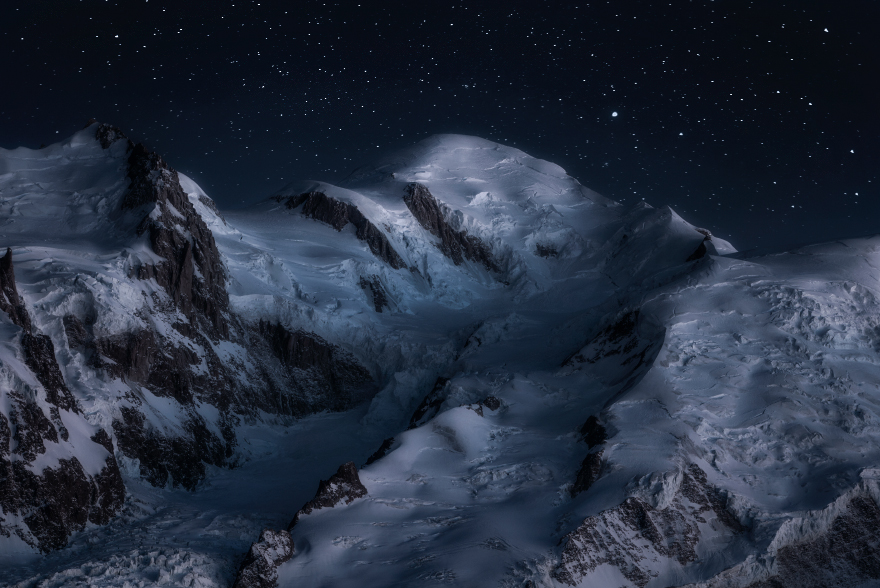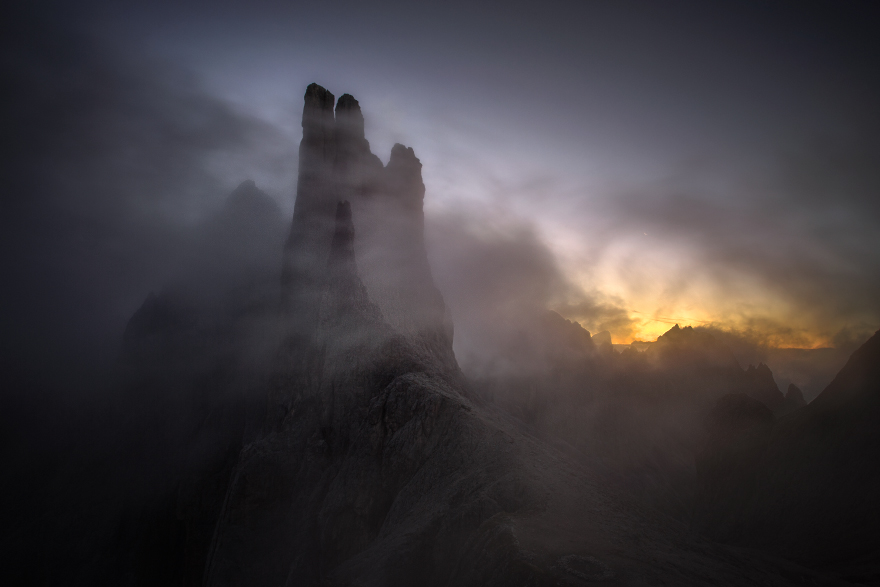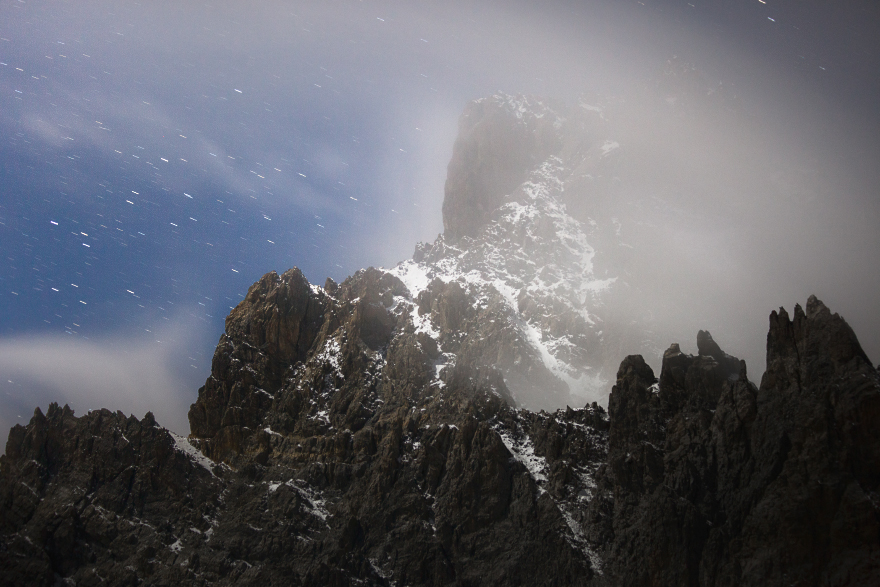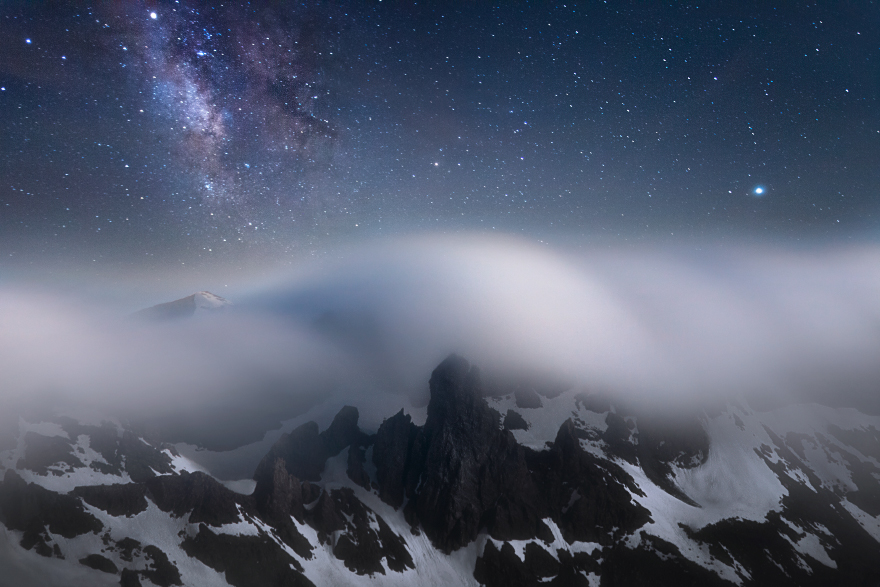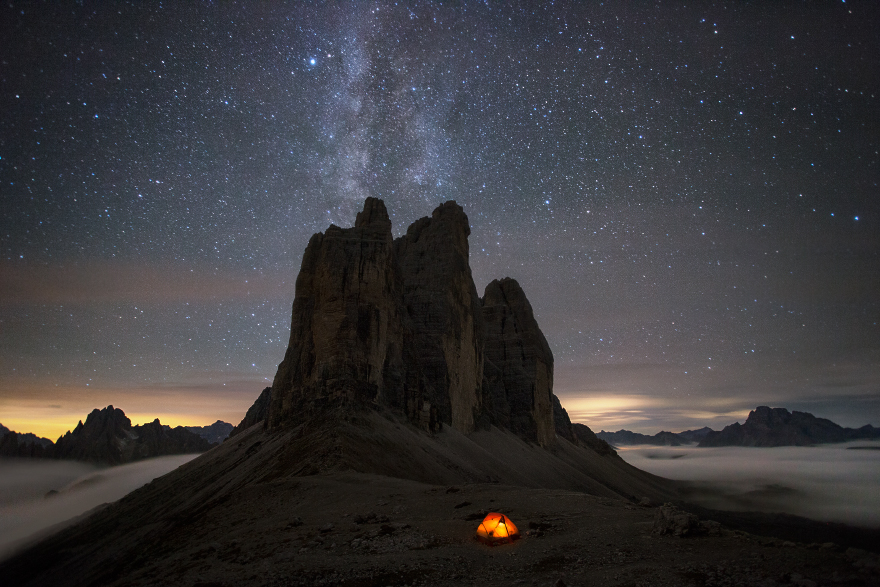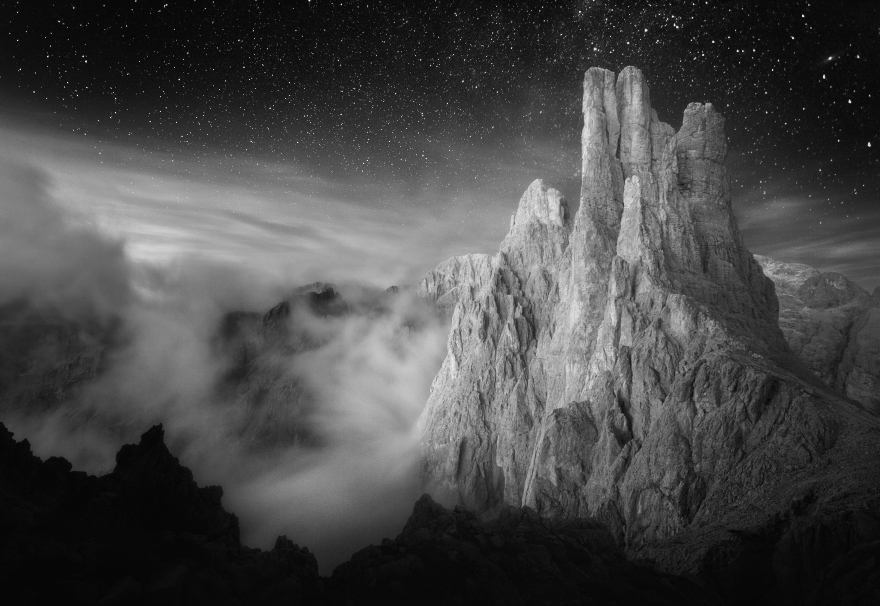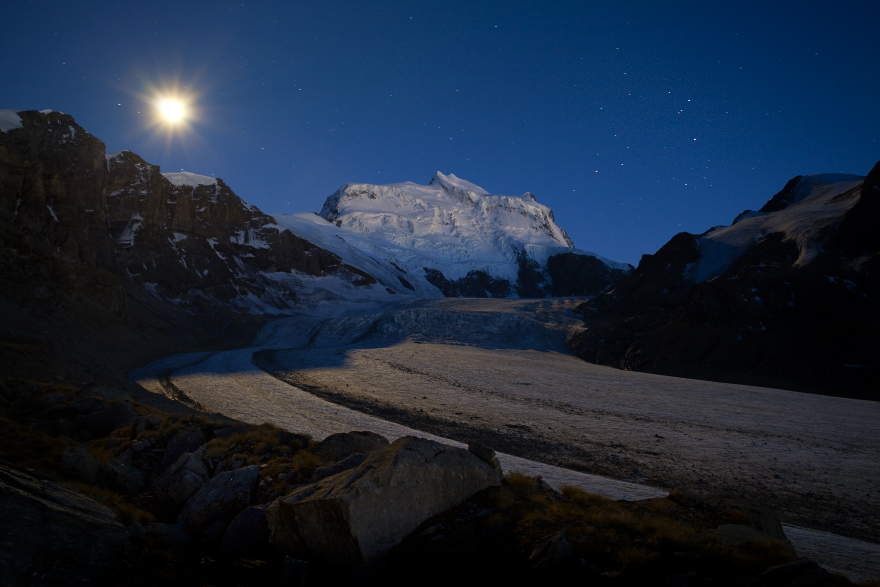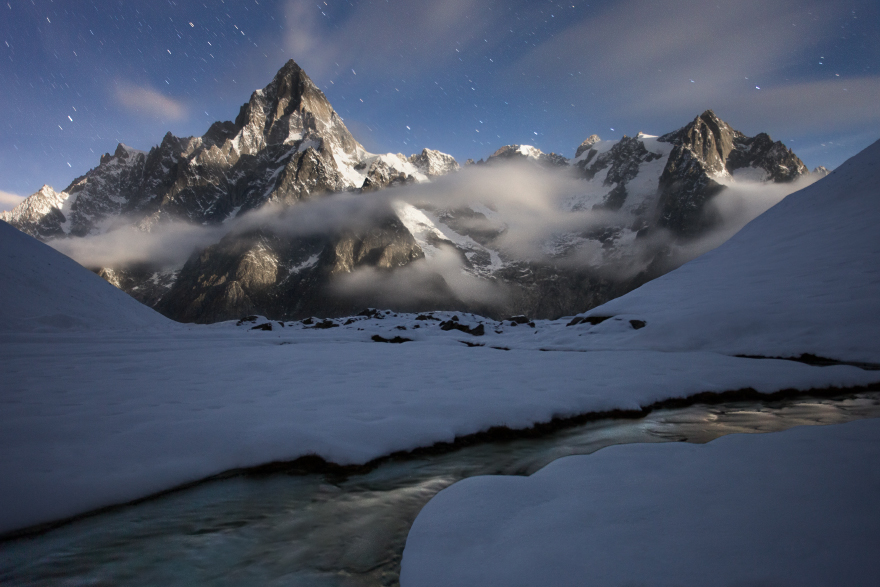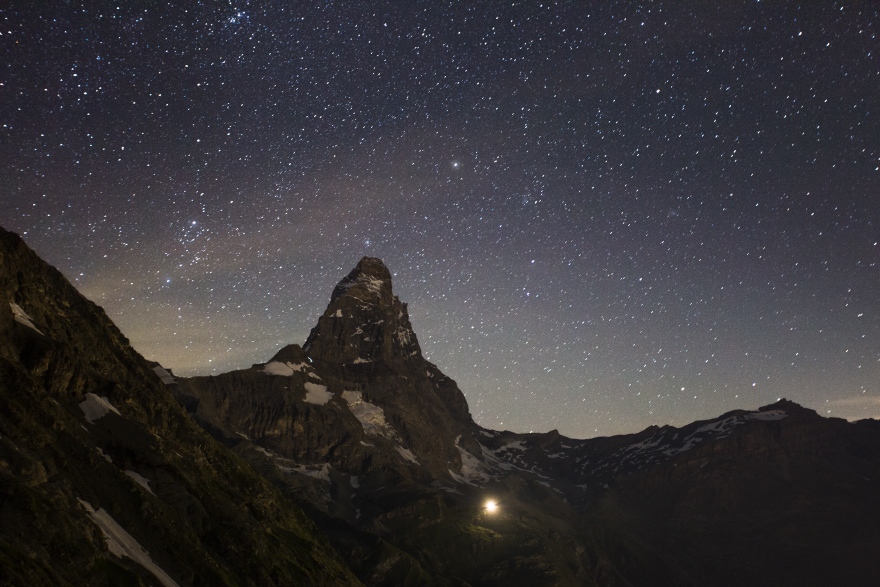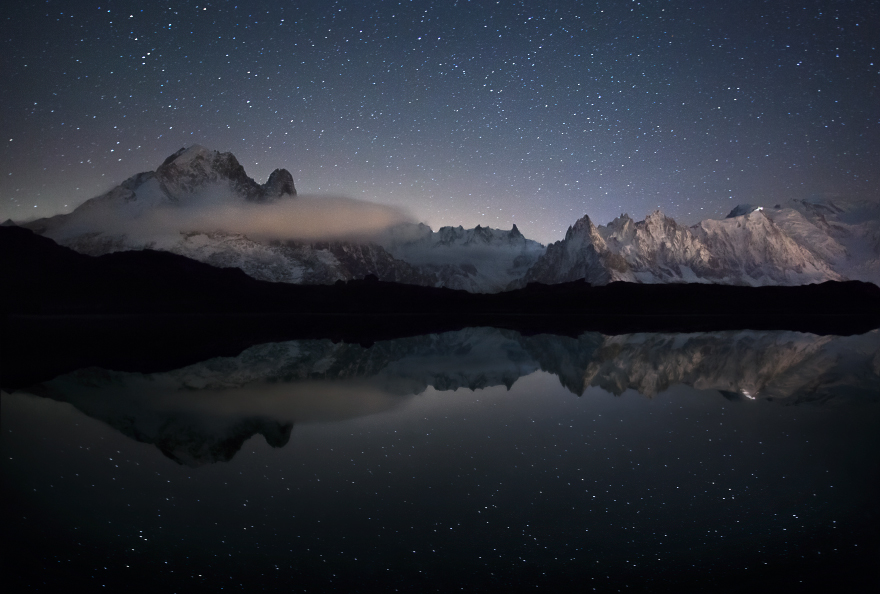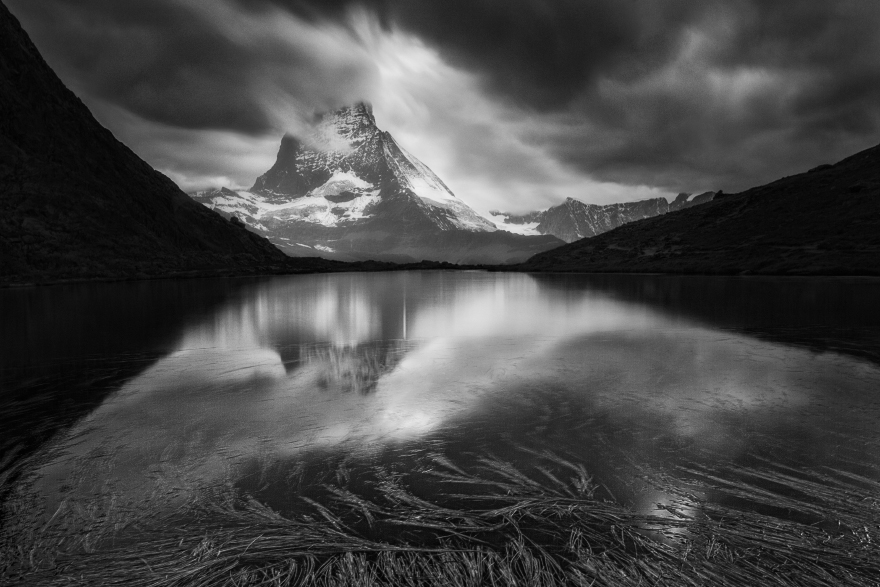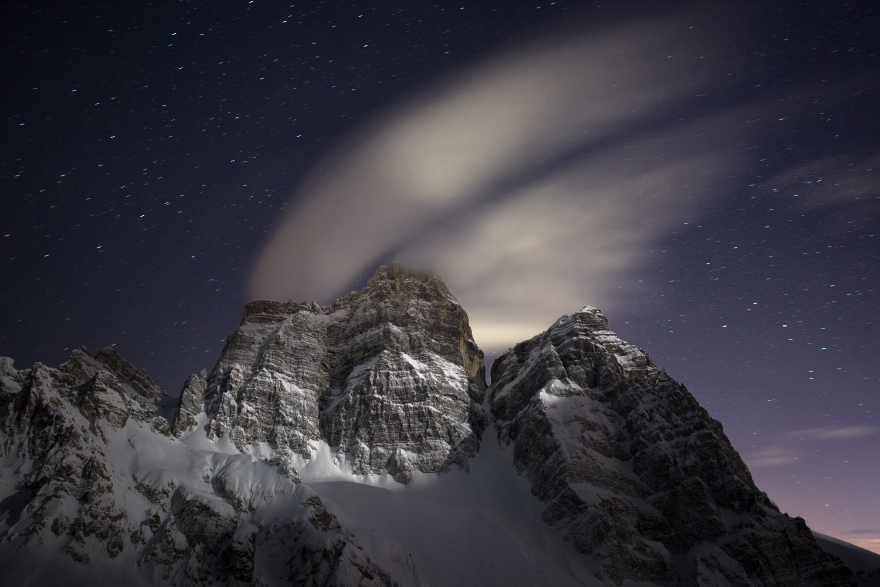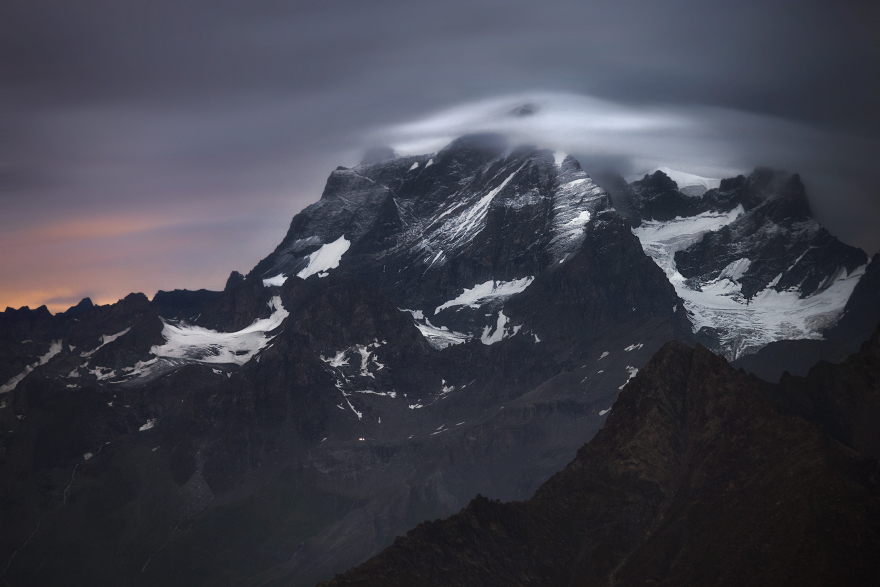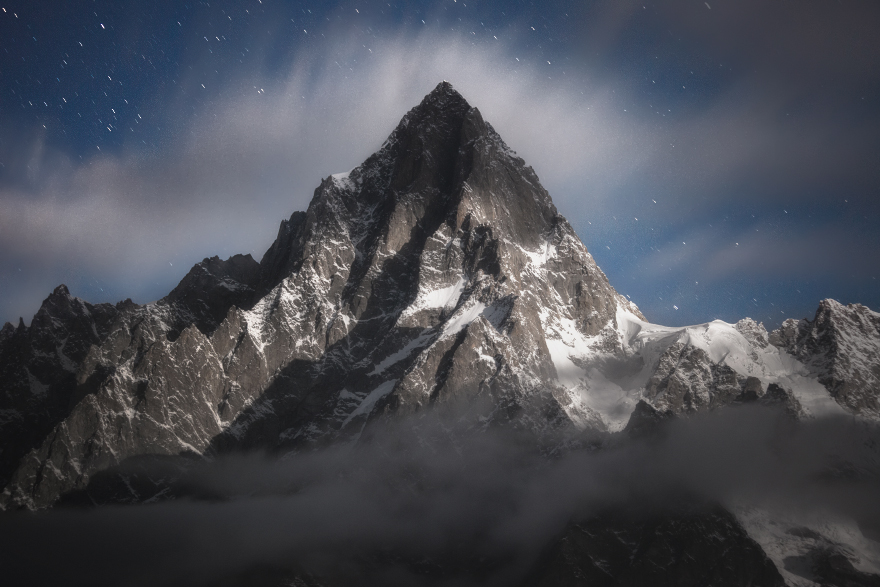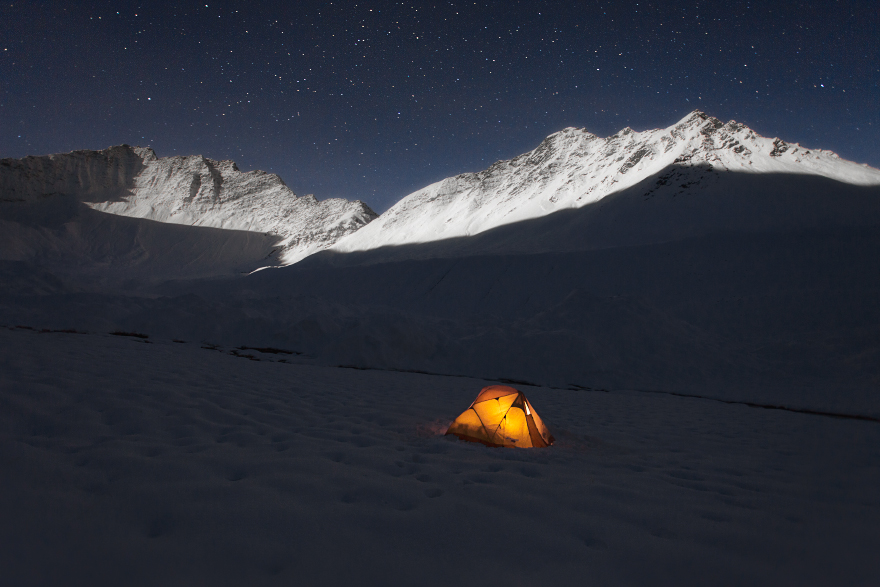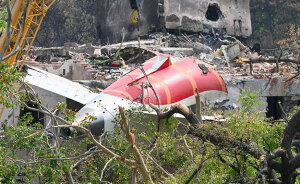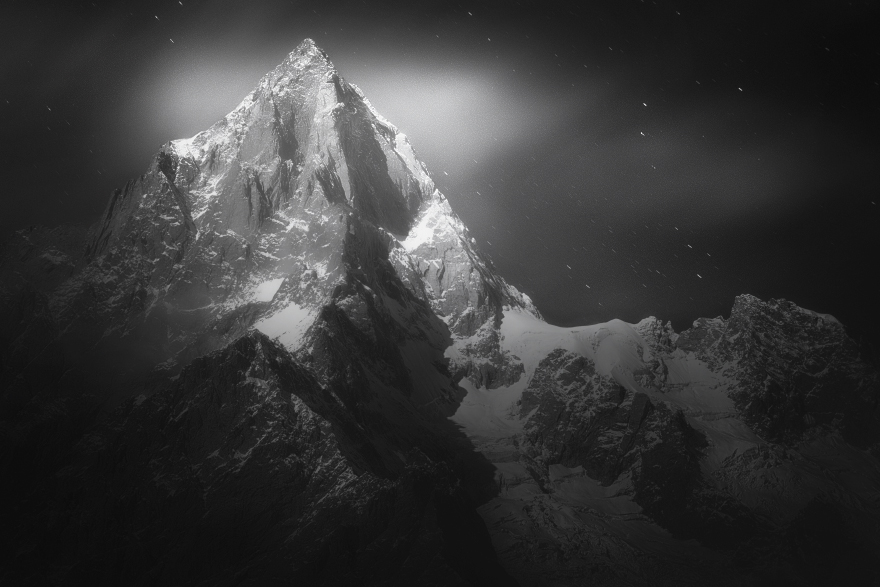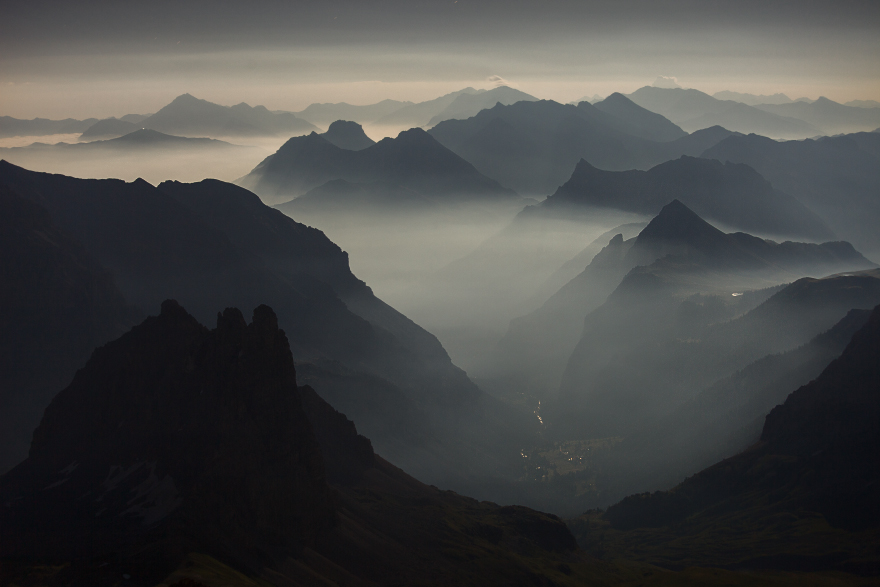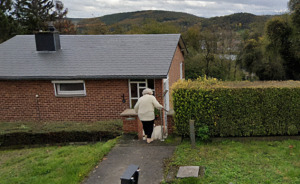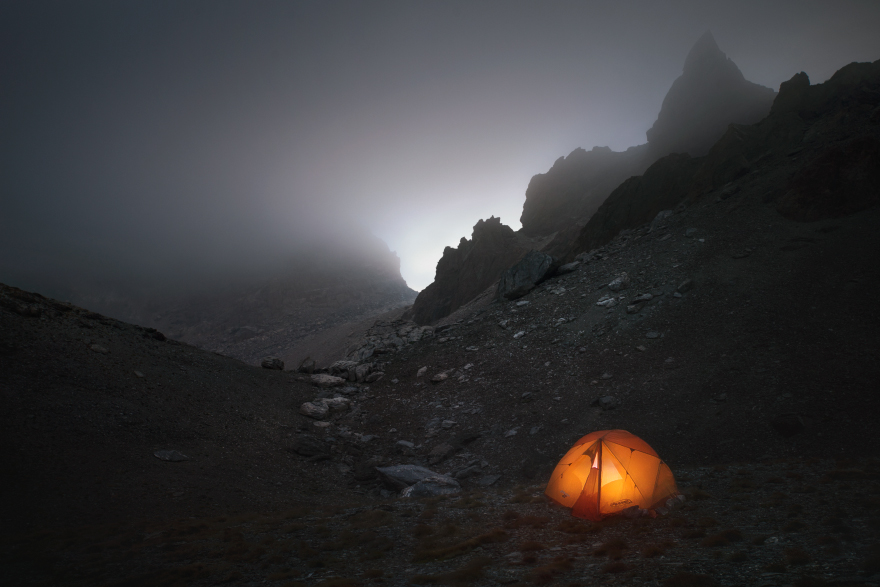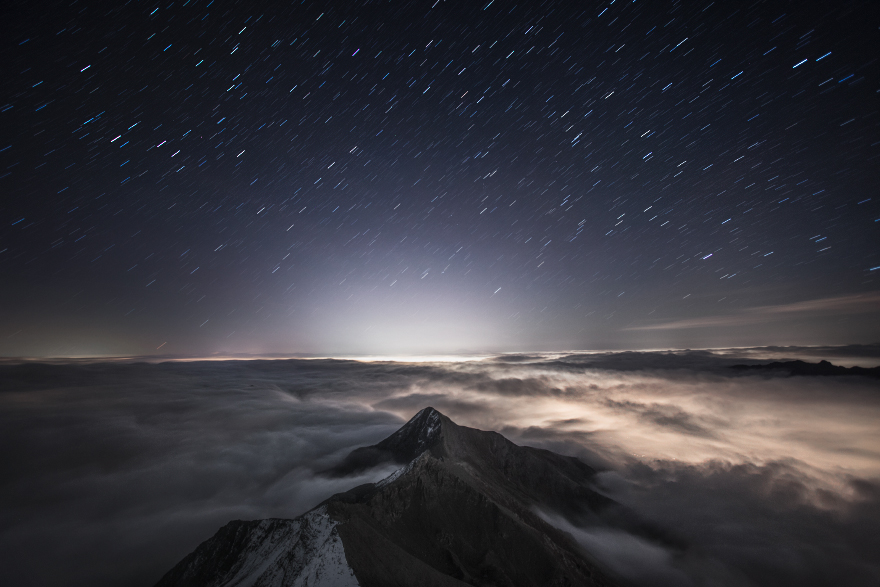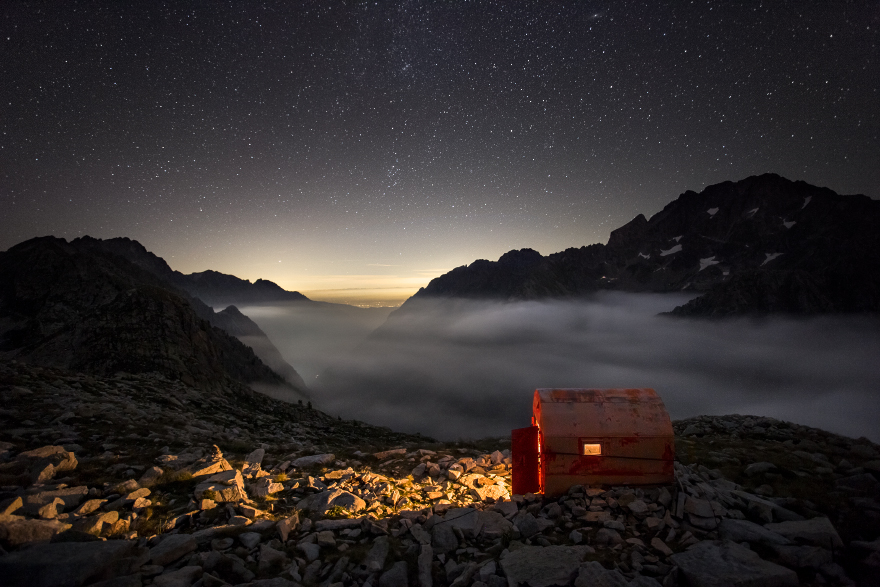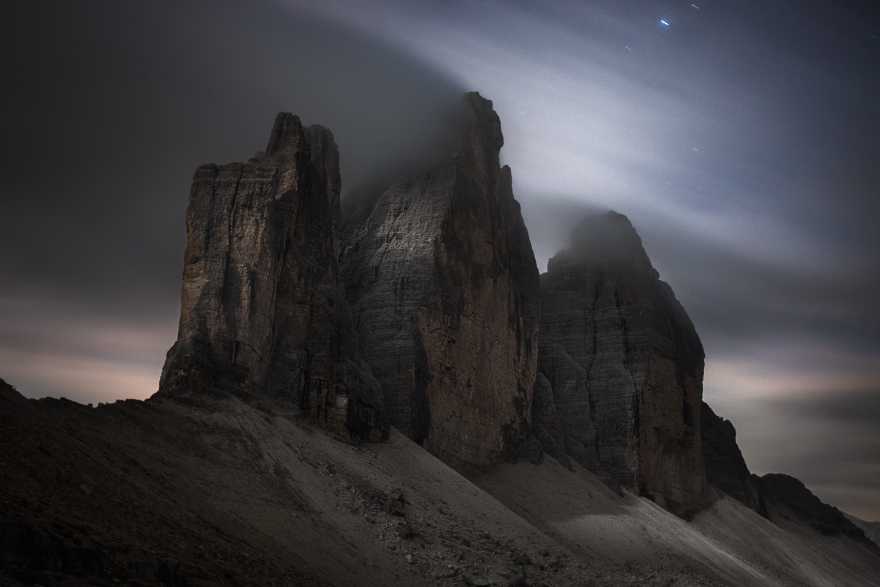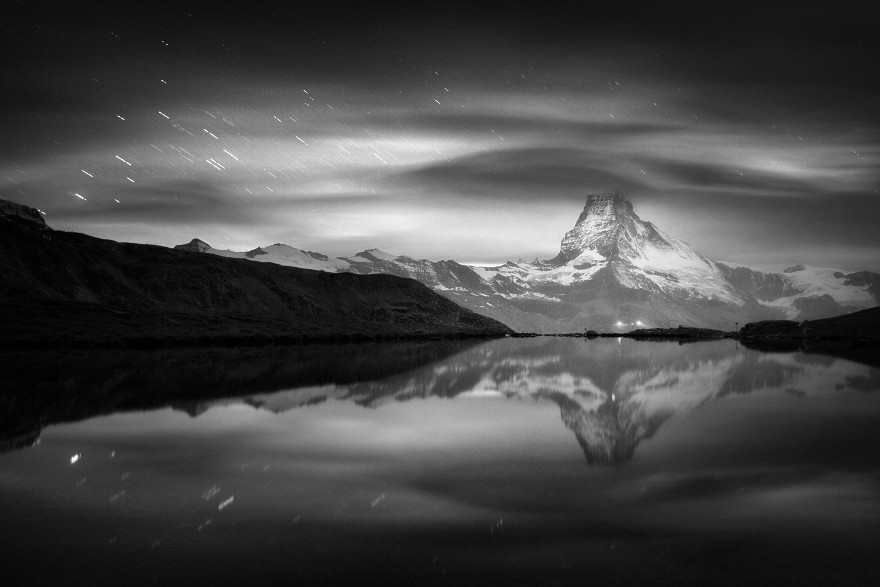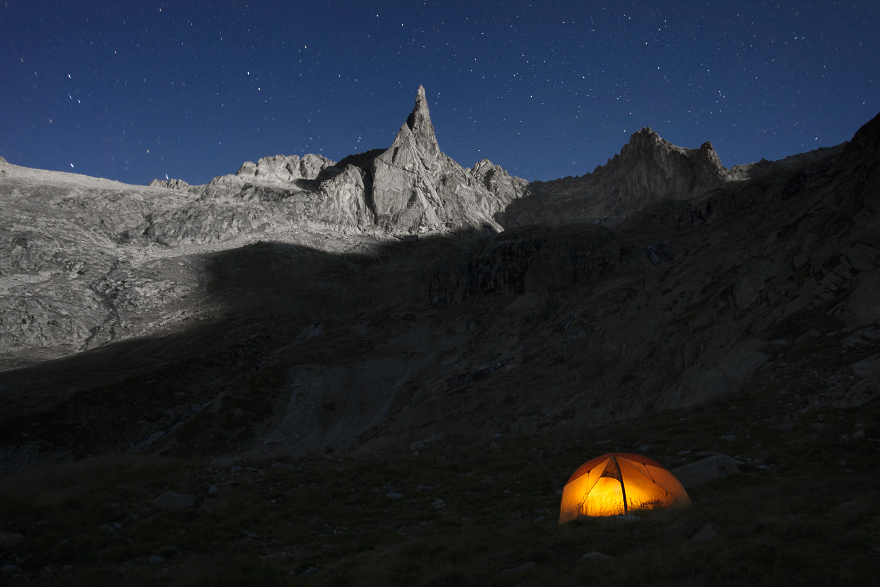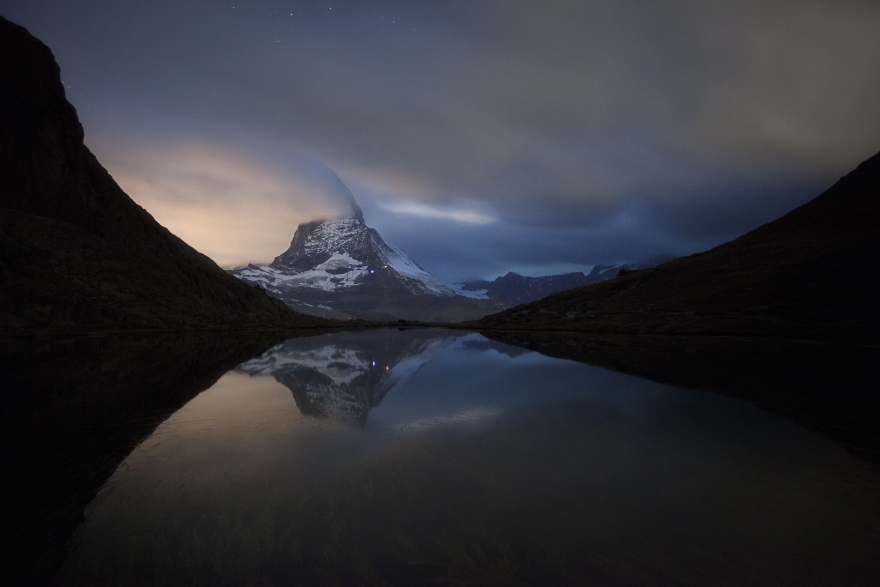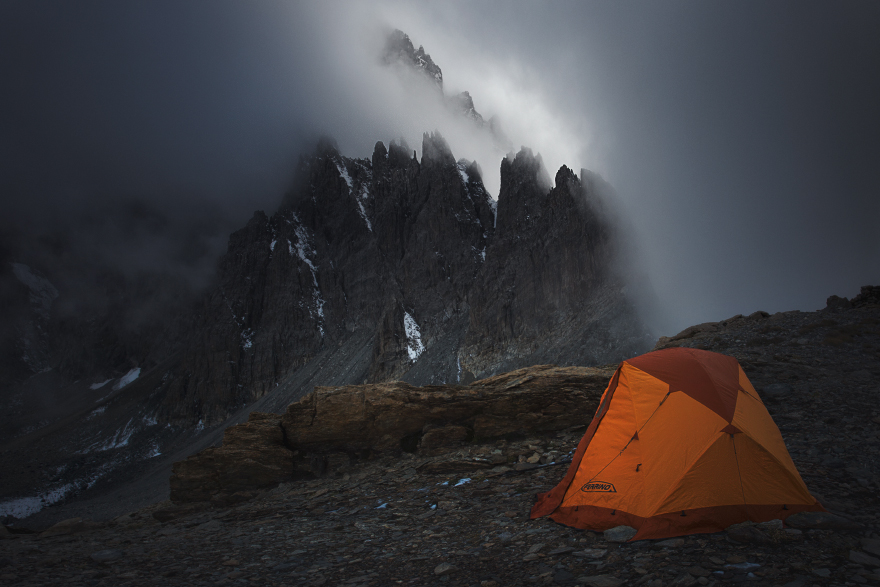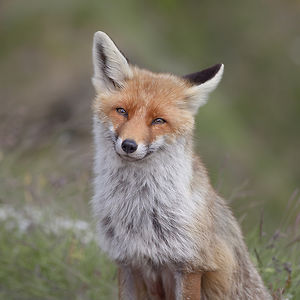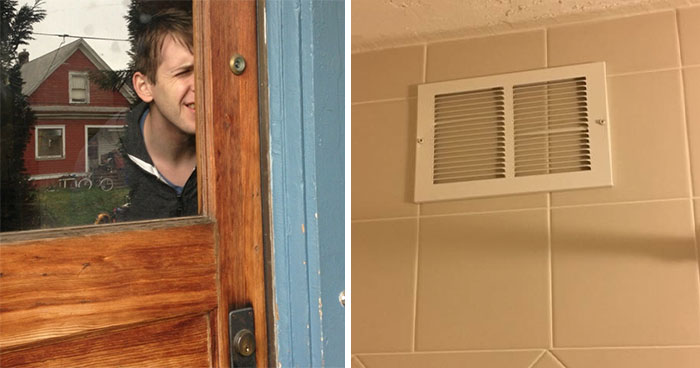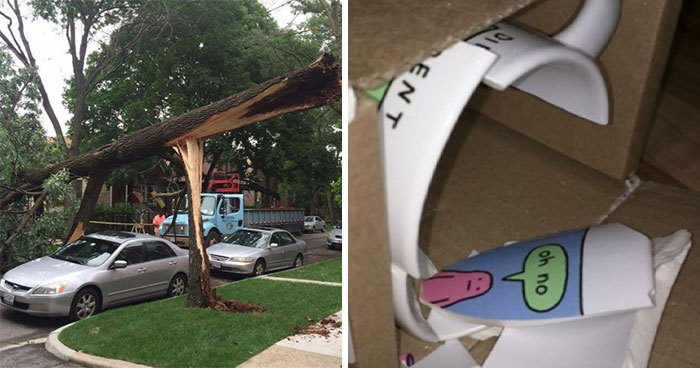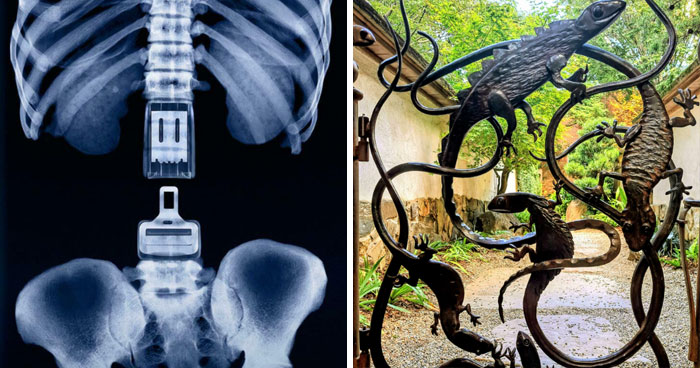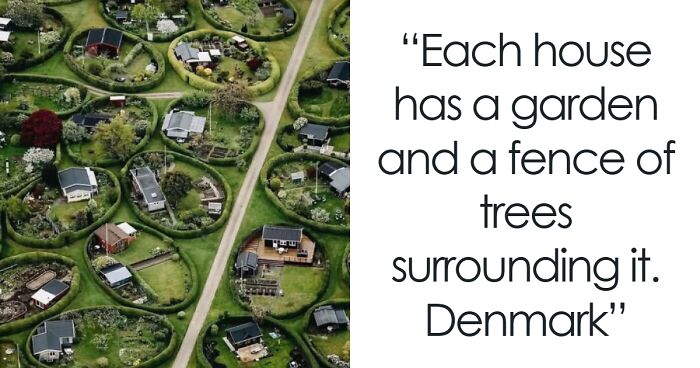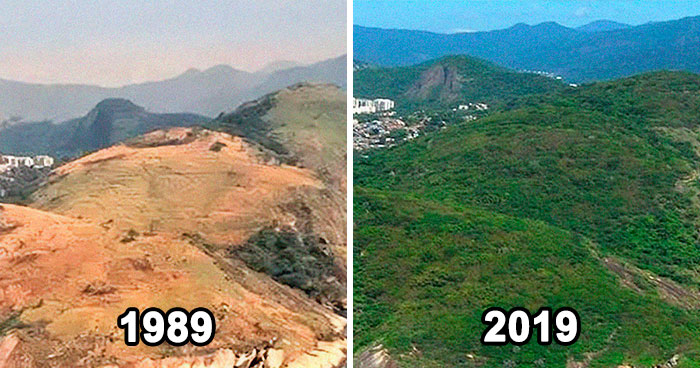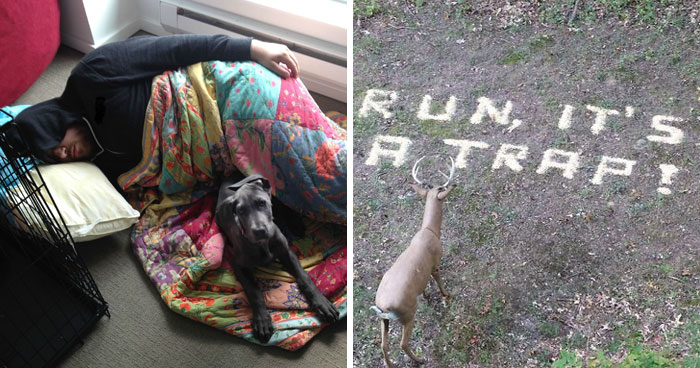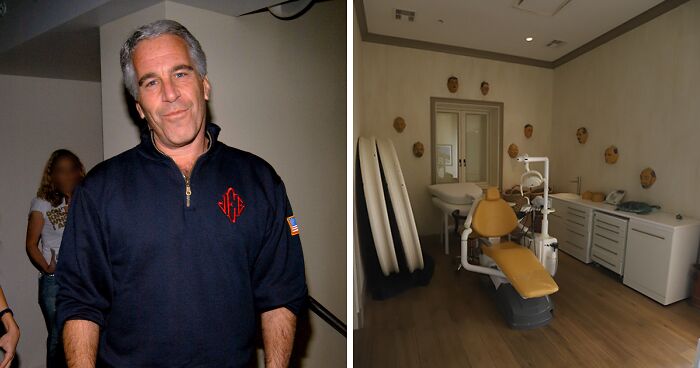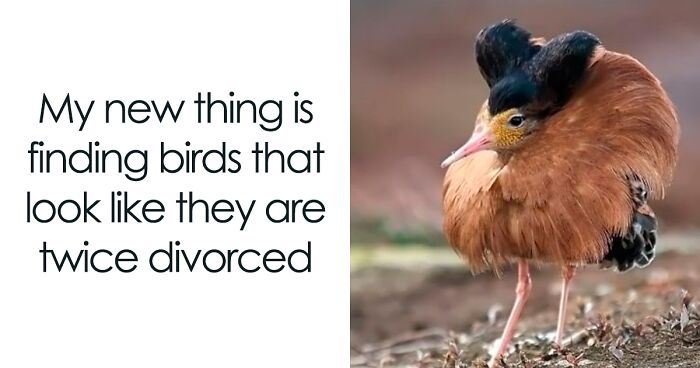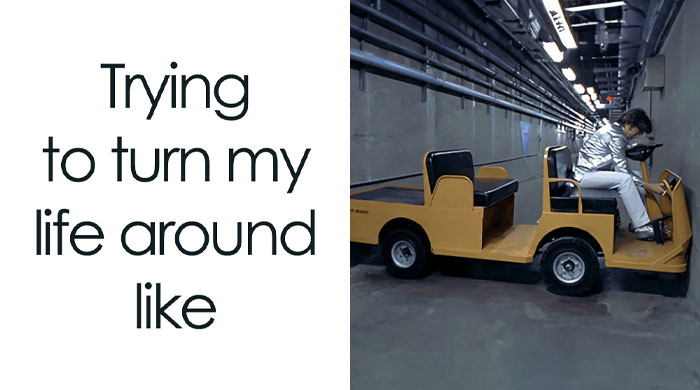My name is Roberto Bertero, I am an Italian photographer in love with night photography on the Alps.
I practice this specific kind of photography for years now (from when it was a cutting-edge activity) and I can say it's the most instinctive and natural way I know to connect one of my deepest passions ever - the science of the cosmos - with my ordinary life.
Because, during those priceless moments on the Alps, the act of taking a good photo is like accomplishing a "bridge", a "gateway", between the ancestral questions, that will never find an answer through our limited senses, with the tangible reality of this world.
The good news is that I can do this activity with three means I have at my disposal: health, passion, and technology.
This is just wonderful, especially if you think that many of the photographs I've taken, 15 years ago would have been impossible... but, thanks to the advancement of cameras, and their performance at high ISO, now the night sky documentation is within the reach of any dedicated photographer.
Photographing the Alps at night does not just mean "capturing the Milky Way and tons of stars", rather it mainly means knowing how to read and interpret the mysterious shadows generated by the delicate light of the moon, means knowing how to set up your camera for capturing with long exposures the rivers of clouds and mists floating below your vantage point, means to have the sensibility to read any distant faint light (yes, also light pollution can sometimes be a great ally), and it also means being creative (as in any other photographic genre) thinking of compositions that may also include elements characterizing your own night-time experience, such as a tent lit by inside, a small shelter, or even dwelling in capturing star trails, through very long exposures, and all this, possibly, can also be done with not necessarily high-end equipment.
But, to be fairly honest, the more we can take quality camera gear with us on the mountains (I know, it weighs, but it's worth it!) the more our creativity will not meet problems or restrictions, and the final product will be both technically and artistically good.
What matters most for me is capturing what I see at its best. The awe I feel while witnessing such gorgeous nightscapes leads me to think that the limit has not to be me (nor my skill, nor my equipment), as I must be purely the connection between the natural event and the final image. And I want to be up to it.
So: respect, dedication, investment, fatigue (both physical and mental), and the aim to never stop, always go further, always be growing.
Actually, this activity hasn't made me financially rich, quite the opposite... and it hasn't brought me free time, it has absorbed it all... nevertheless, for some inexplicable reason I continue to practice it, I just have to. It's not a choice, it's a necessity.
I hope the result of my hard work can speak to some of you, communicating the silent voice of the high mountain at night.
If this happens what I have done and what I will continue to do will make even more sense.
More info: Instagram
This post may include affiliate links.
Milky Way Above A Sea Of Clouds
This photograph was taken on June 28th, 2012, after moonset, from the summit of Mount Rocciamelone (3.538 meters / 11,603 feet), Italy.
The infinite is my favorite subject. Since I can’t go into deep space, I am constantly searching for it here, on Earth…
The point of view in landscape photography is often from the plain. This happens for obvious practical reasons. That’s why I’ve always dreamt of taking pictures from the rarest viewpoints.
Here you can see the Milky Way cutting the night sky in the south direction, so it is perfectly aligned with the distant pyramidal summit of Monviso (3.841 m). This alignment occurs at the beginning of every summer night, then gradually the Earth moves eastward, and the starry sky obviously to the west.
However, the particularity of this wonderful night was the presence of an infinite bank of clouds, approximately 800 meters below the summit where I was spending the night. The lights of the valley below turned this mass in motion in a sort of “primordial ocean”. This was of the most spectacular scenery I have ever seen.
Alignment: Mars, Saturn, And Jupiter
This shot was taken on July 10th, 2018, from the summit of Mount Rocciamelone (3.538 meters / 11.603 feet), Italy.
Undoubtedly, the most special thing of that night was the opportunity to observe an excellent planetary alignment: Mars to the left, Saturn in the band of the Milky Way, and Jupiter to the right.
You can also see the silhouette of another guy who also spent the night on the summit, which stands out clearly thanks to the underlying lights of the Susa Valley.
Above The Darkness Of The Night
“If I have the gift of prophecy and understand all mysteries and all knowledge, and if I have all faith so that I can move mountains but do not have love, I am nothing.”
In photography terms, even if I avail myself of the best cameras and lenses on the market, read what famous authors say about how to tell a visual story without the love for adventure, I am nothing.
The shot was taken on June 27th, 2012 at 10:42 p.m. from the summit of Mount Rocciamelone (3.538 m), Italy, as the moon (phase 57%) continued its slow journey to the west. After moonset, I took a bunch of interesting photos to the starry sky (then published in various magazines). I’ve always postponed the consideration of this photo because I thought the scenery was a bit “chaotic”… anyway, all in all, I think it expresses quite well what it means to be above a sea of clouds at night.
On the right, we have the moon, while on the left is perfectly visible the Scorpius constellation. Under the “primordial ocean” of clouds are filtering the lights of the Susa valley 3.000 meters below.
Emerging From The Clouds
This photo shows the western side of Mount Rocciamelone (3.538 meters / 11,603 feet), overlooking the Val Cenischia (Italy).
The small point of light halfway up the slope is a mountain pasture. This is a scene that I’ve been trying to capture since a long time from the surrounding mountains of Mont-Cenis, and only this shot fully convinced me, thanks to the perfect weather conditions: a carpet of clouds (from which are filtering the lights of the underlying village of Moncenisio), together with higher clouds, quite scenic, which fortunately are not obstructing the view toward the whole size of the mountain in its lovely winter livery.
In other occasions, I happened to immortalize this scene with the mountain barely visible, or with too clear weather and no cloudscape… in short, in this photographic genre it is very rare to find all the elements in perfect balance, but when it happens it is really important not to miss the moment!
Fort Of The Clouds
This artillery was used during the Second World War.
It is located on the summit of Mont Chaberton, a 3.131 meters (10,272 ft) peak in the French Alps in the group known as the Massif des Cerces in the département of Hautes-Alpes. This very impressive fortress was dubbed “Fort of the Clouds” and mounted eight 149mm guns in individual masonry turrets, which were often hidden in the clouds. Built between 1898 and 1910 by the Italians to control the Montgenèvre pass, this fort was then considered as the highest and most powerful of Europe. Nine soldiers died in this fort, and fifty were wounded.
In this night picture, I’ve focused the attention on the most damaged tower… it seems to have silently observed, for a long time, the wonders of nature and the madness of men. An endless carpet of clouds was surrounding the summit, on a starry, insanely cold, windy, silent night.
Freney Mont Blanc
Star trail, single exposure lasted 1 hour.
You are looking to the otherworldly area below the Freney, southwest face of Mont Blanc massif, Italian side. One of the most geometric locations of the Alps, because of the harmonious relationship between peaks, stars (the Polaris is exactly above the Aiguille Noire) and Earth’s rotation.
From left to right: Mont Blanc de Courmayeur, Aiguille Croux, Aiguille Blanche, Aiguille Noire, Mont Rouge de Peuterey.
Above: Polaris
A faint light from the west: moon (33%) just set.
Light from the east: the area of Courmayeur, many km far away but present in the form of light pollution.
One of the main reasons that lead me to continue this photographic activity is the joy of discovery. I guess this is why I’m also starting to appreciate more and more the star trails… yes, for the “tale of the unexpected” within this photography genre. Of course, knowing the cardinal point I’m directing my camera I can easily predict the shape that the trails of stars will assume (due to the Earth’s rotation). Also, I can carefully choose the focus, composition, white balance, estimate according to the conditions of non-light the various settings, yes I can do this – I have to – nevertheless, just ask any sincere photographer, the end result of a star trail is always an enigma. A most pleasant one! It’s amazing to note the amount of light & color a camera manages to capture at night, in the dark, just continuing to “observe” for an hour, constantly and relentlessly, the spot we have carefully chosen! Well, this is indeed something that our eyes could never do, our eyes can look only frame by frame, we are technically not able to make the sum of light in time. So, what to say, except “thanks to the cameras for this!”… for the chance to discover new things and also for helping us to think in a not too anthropocentric way, reflecting on the fact that there is not only our human way to see. The way we see is only one possible reading of the “reality”, so, let’s discover the others!
Night By The Lake
The simple idea behind this photo is not to provide a picture of the Matterhorn (which has already been photographed a couple of times, I guess), but rather to frame the sense of silent peace, at night, by the shores of the alpine lake Stellisee (2.537 m).
Aosta Valley Beneath The Clouds
This night shot was taken from the Testa di Liconi (2.929 m). It portraits the Aosta Valley covered by a thick blanket of clouds that glitters from the lights. Clearly discernible in the distance are the pyramidical shape of the Grivola (3.969 m) and the Gran Paradiso (4.061 m) to its right.
Rivers Of Clouds At Moonlight
A sea of clouds, exposed to the south-east, is lit by the moon (63%) rising in the east.
Yes, a huge mass of clouds slipping down steep rocky ridges from a height of about 2.900 meters. The shot was taken at night on September 6th, 2012, from the summit of Mount Rocciamelone (3.538 m), Italy.
This is one of the most otherworldly photographs I’ve taken so far. Thanks to the intrinsic magic of the night and to the privilege of being there, silently admiring this amazing moment. This 195 seconds exposure, at 115mm on full frame, turned the slow passage of the clouds in a sort of “silky waterfall”.
A few star trails are already visible, despite the exposure wasn’t particularly long. I guess we all know as the consequences of Earth’s rotation are more obvious when using a telephoto lens. The intensity of colors, contrast and white balance are strongly faithful to the scene.
The main mountains visible here are the Uia Ciamarella (3.676), P.ta d’Arnas (3.560) and, at the horizon, the south-west face of Gran Paradiso (4.061).
Silent Immensity
This shot was taken on March 14th, 2012, from the summit of Mont Brévent (2.525 m), France. During one evening-night-morning spent up there freezing my tail off, and, also, contemplating the immense beauty of the Mont Blanc massif north face!
A bit on the right of the summit you can see the brilliant star, Sirius. I’ve decided to capture the huge area of the Mont Blanc summit (4.810 m) during the late evening transition time right after the blue hour, when the camera through long exposure is still able to perceive some sort of “atmospheric light”, when the light pollution from Chamonix is still not too invading, and before moonrise that would have spoiled the sight of the first stars in the sky.
So: insanely great subject, right place, and absolutely precise time window.
Unfortunately, at this resolution, it’s not possible to see the Refuge Vallot, located at 4.362 meters above sea level. It’s placed on the iced crest on the right… in the original hi-res file is perfectly visible the entire metal structure!
The Creation
Rosengarten, Dolomites. The Vajolet Towers at dawn, mystically shrouded in mist.
There are scenes, moments, experiences in our lives, which can hardly be expressed in words. In some cases, a simple image can be more direct, although it is not always easy to “grab the instant”. But it’s always worth at least a try.
Brec De Chambeyron At Moonlight
Summit area of the Brec de Chambeyron photographed at moonlight.
The Brec de Chambeyron (3.389 m), is a mountain of the Cottian Alps on the border between France (Ubaye Valley) and Italy (Maira Valley). The word “Brec” or “Bric” in French stands for a mountain resembling a rocky tooth.
The Eternal Rivers
I have a deep interest in portraying the worldly elements, especially when they are connected with things that go… far beyond. Hence the title “The Eternal Rivers”, as the Milky Way here seems to find the continuity in the clouds of our tiny planet. This photograph was taken in Val Cenischia, Italy/France, shortly after midnight on June 17th, 2018, thanks to the union of two shots taken with different exposures. I saw that the mountain ridge in front of me was caressed by slowly floating clouds, so I immediately understood that in order to get a dreamy-looking scene I would have to dedicate a quite long exposure to the clouds and the classic exposure for the starry sky.
So I did, and these clouds turned out like rivers of cream and the stars perfectly spot-like. The result was obtained! However, the clouds also benefit here from some lunar lighting, as the moon
had just set. Enough light reverberation to still offer some three-dimensionality to the earthly things without compromising the darkness that the Milky Way requires.
Mystical Intersections
The Milky Way aligned with the northeast face of the Tre Cime di Lavaredo (Dolomites) seems flowing into the two rivers of clouds below. Hence the title of this photograph.
Among the many stars, is perfectly recognizable Altair, the biggest and brightest on the left of the Milky Way.
A misty evening, with fog and low clouds, allowed me to take some lovely shots during the blue hour, just along the path that leads to the Forcella Lavaredo, here portrayed in the picture. Place where I’ve then mounted my tent (visible in the lower center) for the night.
So, I’ve got also the priceless opportunity to admire the dawn and sunrise of the next day, both simply magical.
The Enchanted Castle
This shot was taken in front of the southern side of the world-famous Vajolet Towers, South Tyrol Dolomites. It is actually one of my favorite places in the Alps.
Here you can see the transition between the blue hour and the night.
The moment when the stars appear in the sky, or, at least, when the camera begins to capture them. In the upper right corner, you can see the Andromeda Galaxy. I opted for a black and white photograph just to make the most from this almost otherworldly atmosphere.
Grand Combin In The Moonlight
This is the north face of the Grand Combin, a 4,314 meters (14,154 ft) high mountain in the western Pennine Alps in Switzerland.
At the beginning of the night, the moonlight illuminated the Corbassière Glacier (9.8 km long, with an average width of slightly more than 1 km and covering an area of 17.4 km²).
Magic In The Moonlight
This is the fantastic face of the Mont Blanc massif as seen from the Malatrà plateau at moonlight.
The sector goes from the glorious Pointe Walker (4,208 m) of the Grandes Jorasses to the Mont Gruetta (3,684 m). A sublime view, obviously thanks to the pyramidal shape of the Pointe Walker, was, in fact, what truly inspired me to visit this place.
It’s like having an immense pyramid of Giza in Val d’Aosta!
Matterhorn Under The Stars
The Matterhorn (Cervino), by some just respectfully called “The Mountain”, at night under a clear starry sky.
The light of the refuge Duc des Abruzzes à l’Oriondé is clearly visible and, towards the west side, along with the Italian normal route, there is also a tiny trail of light left by the frontal lamps of the climbers who were approaching the Refuge Jean-Antoine Carrel.
Mont Blanc In The Mirror
This is the French side of the Mont Blanc massif mirroring in the still waters of lake Cheserys (2.211 m), high up in the Aiguilles Rouges above the Chamonix valley.
Night shot, taken on September 13th, 2012, at 10:07 p.m.
Waters of alpine lakes are not always still as well as not always in motion. Let’s say that during regular weather conditions they are just alternating phases in accordance with the winds. Sometimes, even in this Cheserys area, I’ve seen photographers observing the waters a bit rippled… and then moving on, looking for other places. Patience is the base, also while we pay attention to reading the phases of the wind, somehow predicting the moments of quiet, having everything already set up to take the shot. Usually, during the moments of wind, I just define perfectly the composition and the camera setting, in order to be totally ready when everything will start to calm down.
This kind of photography with starry sky rarely exceeds the 30sec of exposure (because of Earth’s rotation), therefore the fact to be operating in such a relatively short time increases considerably the chances to get water totally still during that specific time window. Sometimes it’s possible, sometimes not. In any case, it’s always worth trying.
The Force
This night shot was taken practically at the end of the blue hour from the lake Riffelsee (2.757 m), depicting the Matterhorn transfigured between immense waves of clouds.
Observing this, in the dark, felt like becoming a part of Dantesque vision. In the foreground, I’ve been careful to include the algae of the lake, as almost longing to reach a higher state of being towards the mountain.
I take this opportunity to quote a sentence of Master Yoda, from Star Wars Episode V, which is actually the heart of the entire etiology: “My ally is the Force, and a powerful ally it is. Life creates it, makes it grow. Its energy surrounds us and binds us. Luminous beings are we, not this crude matter. You must feel the Force around you; here, between you, me, the tree, the rock, everywhere”.
The Fortress
Like a mighty fortress, with a huge banner hoisted on the towers, appeared mount Pelmo at night, in the moonlight.
These lovely clouds lasted only a few minutes, enough to seize the opportunity of a few beautiful shots.
Location: Val Zoldana, Dolomites, Italy.
Grand Combin At Night
This is the Grand Combin (4.314 m), one of the greatest mountains of the Aosta Valley (Italy), observed at night with a sort of lenticular cloud all around the summit area. It looks like it has a magical hat because during the long exposure of 106 seconds the clouds obviously moved a bit, thus offering this ethereal aura. Generally, during overcast nights what is lost in the stars is earned in the clouds.
Grandes Jorasses, Pointe Walker
Night shot portraying the Pointe Walker (4,208 m; 13,806 ft), the main summit of the Grandes Jorasses, illuminated by moonlight.
Mont Blanc massif, Italy.
Shades Of Pale Light
The unique beauty of the light provided by the moon is what offers three-dimensionality to the landscape, just like the sun, but in a much more delicate way… let’s call it a “whispered three-dimensionality”. Something always very elegant and dreamy.
In a world that loves to flaunt things, often of vulgar quality, it is always a privilege to be face to face with the immutable, subtle, aesthetic senses dictated by nature. And it is a pleasure to know that all this true beauty will survive us. Here you can see the Malatrà plateau (Val Ferret, Aosta Valley, Italy) flooded by snow, exactly when the moon is beginning to illuminate the surrounding ridges. My inevitable tent has allowed me to spend the night on site.
The Otherworldly Pyramid
Mont Blanc massif, Italy.
The pyramid of the Grandes Jorasses, to be precise the south-east face of the Pointe Walker (4,208 m; 13,806 ft), portrayed from a slightly different angle compared to a previous photo of mine. Here, for a change, the treatment is monochromatic. The light is always lunar and the mists were fluttering, perfectly accomplishing their job.
Vallée Etroite
The night view of the Vallée Étroite, France, and the mysterious mists of that lovely night.
Clearly visible the inhabited zone, the starting point of the trail to the summit of Mount Thabor (3.178 m), on which I stood. Under the moonbeams, there is also visible a tiny sparkle of the Lac de Thures (2.184 m), as well as the small light of the cable station on the top of Mount Fraiteve (2.702 m).
Beneath Misty Peaks
Wrapped in the mysterious atmosphere of the night, my tent gently glows like an opal near the base of the Brec de Chambeyron, Val Maira (Italy).
Interstellar
This night shot was taken, looking east, from the summit of Mount Rocciamelone (3.538 meters / 11,603 feet), Susa Valley, Italy.
In the distance, an opening in the carpet of clouds, just above the city of Turin, let filter all the light pollution of the big town. Also, thanks to proper long exposure, this source of light appear as a sort of portal leading to distant universes. Presence also of faint moonlight (phase 27%) almost set in the west.
Despite the considerable number of places I’ve visited so far in the Alps, the summit of Mount Rocciamelone has always been, is, and surely will be, one of my favorite places ever… not just because it is the symbol mountain of the valley where I live (the Valley of Susa), rather because due to its height and position it is definitely a place where you can almost reach out and touch the otherworldly, especially during the night.
And that’s what drives me each time to return to the mountains: to be face to face with the otherworldly. Definitely, I do not care about doing anything else while I am there.
The Mysticism Of The Night
This is the lovely bivouac Guiglia (2.437 m), Val Gesso, Natural Park of the Maritime Alps (Italy).
Despite having photographed this lovely refuge during other times of the day, such as sunrise or beneath the moonlight, I’ve chosen to show it immersed in the mysticism of a starry night.
From my point of view, there is nothing more mystical of being away from everything and everyone with the universe above my head, as a blanket. The most silent, immense and full of mystery blanket you can imagine.
Here the gaze is directed toward the north. When following the sea of clouds shrouding the Val Gesso you can see the light pollution coming from the area of Cuneo.
On the right, you can see the west face of Mount Argentera (3.297 meters 10.817 ft), the highest mountain in the Alpes-Maritimes.
There is a tiny light visible just below the Corno Stella – it is the refuge Bolzano (destination which attracts many climbers), and exactly in a straight vertical line above that refuge, on the extreme edge of the photo, is visible the Andromeda Galaxy. If you have a trained eye, you will recognize it.
Tre Cime At Moonlight
This is the world famous Tre Cime di Lavaredo (Drei Zinnen), Dolomites, as seen on October 4th, 2012, at 11:20 p.m.
The lateral lighting is coming entirely from the Moon (73%), rising on the east at 9:05 p.m.
Clouds were moving pretty fast, thus leaving some moonlight filter through the immense cloaks of fast-moving elements. Also, some more light pollution from Misurina is visible here. Altair is shining in the sky, a bit trailing because the exposure definitely exceeded 30 seconds.
Matterhorn Under Attack
Disclaimer: “No mountains were harmed during this photo session”.
Night shot, long exposure, portraying the righteously world-famous Swiss side of the Matterhorn that is being mirrored in the calm waters of lake Stellisee (2.537 m).
I had the chance to frame a temporary opening in large banks of clouds and also caught a few stars. The final result, given the long exposure, is short star trails that may be interpreted, with some fantasy, as an attack on Earth by aliens. Obviously, the clouds are stretched due to their movements during the exposure. I’ve found particularly charming the hat-shaped cloud right above the Matterhorn summit. You can never exactly predict how the clouds will look like at the end of a long exposure, and this is certainly one of the most fascinating aspects of this technique. On the other hand, when you see too many clouds this charm disappears… For instance, later I’ve tried also a star trail of 45 minutes exposure, but it turned into a giant nothing.
Moonlit Landscape
“Backstage shot” taken during a full moon night spent admiring and photographing the sharp-pointed south face of the Aiguille Dibona (3.131 m), Écrins National Park, France.
Here the moonlight had not yet reached the area of my tent, so I took the opportunity to capture some interesting play of light and shadow along the rugged landscape.
Sweet Dreams Matterhorn
This is, of course, the Matterhorn (4.478 m), Swiss side (mainly east face, just with a glimpse of the north)… photographed at night before the mountain went to sleep after a busy day playing with clouds!
The lake is the Riffelsee (2.757 m), an enchanting location where I have spent the night.
The tiny red light visible at the base of the Hörnli ridge is the Hörnlihütte (3.260 m), with another small side light that probably could indicate a camping/bivouac site or something like this. In any case, definitely, another place where I’ll have to spend the night.
The Light Is Dying
My tent and the Brec de Chambeyron (3,389 m), Maira Valley, Italy.
Here you can see one of the most evocative moments of the day: when the light is dying and fading away, leaving me and the surrounding landscape in the dark until the next morning. I can now have access to a kingdom full of charm and mystery.
Roberto Bertero’s passion for night photography underlines the profound connection he feels with nature’s elusive beauty. Just as the moon rises and dances over the landscapes of Los Angeles captured by Dan Marker-Moore, Bertero captures the delicate whispers of moonlight across the Alps.
You can explore how these moments are portrayed through a distinct visual approach by delving into Dan Marker-Moore's mesmerizing timelapse visuals.
Absolutely breathtaking. I love how you describe it as a bridge or gateway. That's often how I feel looking up at the cosmos. Thank you!!
Complimenti Roberto. Hai portato il senso del meraviglioso ai suoi "vertici". Ad maiora semper.
I'm a stargazer on budget who lives in a big city. The light pollution in the city ruins the night skies for me and I can only afford to travel to remote towns a few times during the year. I'm always grateful for pictures like this. Good job, sir.
Marvelous, I wish I can take pictures of the night sky and the mountains like you do, unfortunately I get sick easily in the cold weather, at least I can gaze this picture, thank you for sharing your hard work
Amazing atmospheric images of another world - #20 could almost be on the moon. Thank you
Beautiful. It looks magical. Thank you for sharing and keep safe (Alps can be very dangerous if one isn't careful and well prepared and recently there have been snowstorms in parts of them)
Absolutely breathtaking. I love how you describe it as a bridge or gateway. That's often how I feel looking up at the cosmos. Thank you!!
Complimenti Roberto. Hai portato il senso del meraviglioso ai suoi "vertici". Ad maiora semper.
I'm a stargazer on budget who lives in a big city. The light pollution in the city ruins the night skies for me and I can only afford to travel to remote towns a few times during the year. I'm always grateful for pictures like this. Good job, sir.
Marvelous, I wish I can take pictures of the night sky and the mountains like you do, unfortunately I get sick easily in the cold weather, at least I can gaze this picture, thank you for sharing your hard work
Amazing atmospheric images of another world - #20 could almost be on the moon. Thank you
Beautiful. It looks magical. Thank you for sharing and keep safe (Alps can be very dangerous if one isn't careful and well prepared and recently there have been snowstorms in parts of them)

 Dark Mode
Dark Mode 

 No fees, cancel anytime
No fees, cancel anytime 



